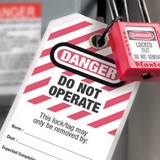Information
-
Document No.
-
Lockout/Tagout Periodic Inspection
-
Metal Recovery Systems 665 St. Cry Rd. St. Louis, MO. 63137
-
Conducted on
-
Prepared by Jason R. Richey EHSS Coordinator Metal Recovery Systems
-
Personnel Present
Pre-certification Prepared by trainer/supervisor
-
Employee has been trained in MRS LOTO procedures for assigned task
-
Employee can identify all stored & kinetic energy sources of equipment<br>
-
Employee has been issued locks, keys, hasp, and tags
-
All locks are unaltered and uniform with plant standards (Red, American Brand); Tags clearly identify ownership
-
Observed Employee
-
Supervisor/Trainer
Lockout/Tagout Process
-
Step 1- Identify energy sources
-
Step 2- Notify others (affected employees and other personnel in area)
-
Step 3- Shut down the equipment using normal stopping procedures for the equipment<br>
-
Step 4- isolate the equipment from the energy source
-
Step 5- Lock out and tag the equipment by affixing locks and tags to each energy sources controlling device
-
Step 6- Release stored energy (capacitor banks, springs, compressed air, steam, hydraulics, etc)
-
Step 7- Ensure area is clear of all personnel and verify isolation<br>
-
Step 8- Perform servicing
-
Step. 9- Release the equipment from lockout/tagout
Verification
-
Employee was able to conduct Lockout/Tagout process correctly and all steps were conducted sequentially
-
Employee demonstrates ability and knowledge to properly conduct lockout/tagout when necessary
-
Employee understands that he/she will be subject to periodic audits as deemed necessary by management<br>
-
Employee understands that violation of lockout/tagout policy can and will result in disciplinary action, up to and including termination
-
Auditor Signature
-
Supervisor Signature












